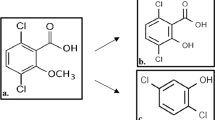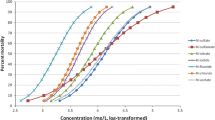Abstract
Nematodes offer perspectives for ecotoxicological research as their characters and most of toxicity assessment focused on Caenorhabditis elegans. In order to enrich the limited numbers of nematode species used for toxicity test, this study assessed the subacute effects of copper and zinc to the life history characters of nematode Acrobeloides nanus. Compared with control, the 72-h effective concentration (EC)50, EC20, and EC10 for reproduction in A. nanus were 1.35, 0.49, and 0.20 mg/L, respectively, for Cu and 829.46, 330.29, and 163.90 mg/L, respectively, for Zn. The EC10 for growth at 72 h and 96 h of the 2nd generation in A. nanus were 1.13 and 0.97 mg/L, respectively, for Cu, and 353.46 and 284.20 mg/L, respectively, for Zn. During the exposure, the effect of copper–zinc on reproduction was less than additive, and the copper–zinc effect on growth changed from a synergistic to antagonistic.
Similar content being viewed by others
References
Anderson, G. L., Boyd, W. A., & Williams, P. L. (2001). Assessment of sublethal endpoints for toxicity testing with the nematode Caenorhabditis elegans. Environmental Toxicology and Chemistry, 20, 833–838. doi:10.1897/1551-5028(2001)020<0833:AOSEFT>2.0.CO;2.
Bongers, T. (1990). The maturity index—an ecological measure of environmental disturbance based on nematode species composition. Oecologia, 83, 14–19. doi:10.1007/BF00324627.
Bongers, T., Ilieva-Makulec, K., & Ekschmitt, K. (2001). Acute sensitivity of nematode taxa to CuSO4 and relationships with feeding type and life-history classification. Environmental Toxicology and Chemistry, 20, 1511–1516. doi:10.1897/1551-5028(2001)020<1511:ASONTT>2.0.CO;2.
Boyd, W. A., & Williams, P. L. (2003). Comparison of the sensitivity of three nematode species to copper and their utility in aquatic and soil toxicity tests. Environmental Toxicology and Chemistry, 22, 2768–2774. doi:10.1897/02-573.
Doroszuk, A. (2007). Populations under stress: Analysis on the interface between ecology and evolutionary genetics in nematodes. Ph.D. thesis, Wageningen University, Wageningen.
Ekschmitt, K., & Korthals, G. W. (2006). Nematodes as sentinels of heavy metals and organic toxicants in the soil. Journal of Nematology, 38, 13–19.
Harada, H., Kurauchi, M., Hayashi, R., & Eki, T. (2007). Shortened lifespan of nematode Caenorhabditis elegans after prolonged exposure to heavy metals and detergents. Ecotoxicology and Environmental Safety, 66, 378–383. doi:10.1016/j.ecoenv.2006.02.017.
Hensbergen, P. J., & Van Gestel, C. A. M. (1995). Combinatie-toxiciteit in het terrestrische milieu. TCB rapport R04, Den Haag: TCB.
Ikeda, M. (1994). Complex exposures: Potentials for assessing integrated exposures. Clinical Chemistry, 40, 1444–1447.
Ingham, R. E., Trofymow, J. A., Ingham, E. R., & Coleman, D. C. (1985). Interactions of bacteria, fungi and their nematode grazers: Effects on nutrient cycling and plant growth. Ecological Monographs, 55, 119–140. doi:10.2307/1942528.
Kammenga, J. E., Busschers, M., van Straalen, N. M., Jepson, P. C., & Bakker, J. (1996a). Stress induced fitness reduction is not determined by the most sensitive life-cycle trait. Functional Ecology, 10, 106–111. doi:10.2307/2390268.
Kammenga, J. E., van Koert, P. H. G., Riksen, J. A. G., Korthals, G. W., & Bakker, J. (1996b). A toxicity test in artificial soil based on the life-history strategy of the nematode Plectus acuminatus. Environmental Toxicology and Chemistry, 15, 722–727. doi:10.1897/1551-5028(1996)015<0722:ATTIAS>2.3.CO;2.
Kooijman, S. A. L. M., & Bedaux, J. J. M. (1996). The analysis of aquatic toxicity data. Amsterdam: VU University Press.
Korthals, G. W., van de Ende, A., van Megen, H., Lexmond, T. M., Kammenga, J. E., & Bongers, T. (1996). Short-term effects of cadmium, copper, nickel and zinc on soil nematodes from different feeding and life history strategy groups. Applied Soil Ecology, 4, 107–117. doi:10.1016/0929-1393(96)00113-8.
Korthals, G. W., Bongers, M., Fokkema, A., Dueck, T. A., & Lexmond, T. M. (2000). Joint toxicity of copper and zinc to a terrestrial nematode community in an acid soil. Ecotoxicology (London, England), 9, 219–228. doi:10.1023/A:1008950905983.
Li, F. F., Neher, D. A., Darby, B. J., & Weicht, T. R. (2005). Observed differences in life history characteristics of nematodes Aphelenchus and Acrobeloides upon exposure to copper and benzopyrene. Ecotoxicology (London, England), 14, 419–429. doi:10.1007/s10646-004-1347-4.
Li, Q., Jiang, Y., & Liang, W. J. (2006). Effect of heavy metals on soil nematode communities in the vicinity of a metallurgical factory. Journal of Environmental Sciences (China), 18, 323–328.
Liang, W. J., Li, Q., Zhang, X. K., Jiang, S. W., & Jiang, Y. (2006). Effect of heavy metals on soil nematode community structure in Shengyang suburbs. American-Eurasian Journal of Agricultural & Environmental Sciences, 1, 14–18.
Marking, L. L., & Dawson, V. K. (1975). Methods for assessment of toxicity or efficacy of mixtures of chemicals. U.S. Fish and Wildlife Service investment control, 67, 1–8.
Nagy, P., Bakonyi, G., Bongers, T., Kádár, I., Fábián, M., & Kiss, I. (2004). Effects of microelements on soil nematode assemblages seven years after contaminating an agricultural field. The Science of the Total Environment, 320, 131–143. doi:10.1016/j.scitotenv.2003.08.006.
Sochova, I., Hofman, J., & Holoubek, I. (2006). Using nematodes in soil ecotoxicology. Environment International, 32, 374–383. doi:10.1016/j.envint.2005.08.031.
Van Gundy, S. D. (1965). Factors in survival of nematodes. Annual Review of Phytopathology, 3, 43–68. doi:10.1146/annurev.py.03.090165.000355.
Wood, W. B. (1988). Introduction to C. elegans biology. In W. B. Wood (Ed.), The nematode Caenorhabditis elegans (pp. 1–16). New York: Cold Spring Harbor Laboratory.
Yeates, G. W. (2003). Nematodes as soil indicators: Functional and biodiversity aspects. Biology and Fertility of Soils, 37, 199–210.
Author information
Authors and Affiliations
Corresponding author
Rights and permissions
About this article
Cite this article
Hao, W., Li, Q., Zhang, J. et al. Utility of nematode Acrobeloides nanus for assessing subacute toxicity of heavy metals. Environ Monit Assess 164, 273–278 (2010). https://doi.org/10.1007/s10661-009-0891-z
Received:
Accepted:
Published:
Issue Date:
DOI: https://doi.org/10.1007/s10661-009-0891-z




